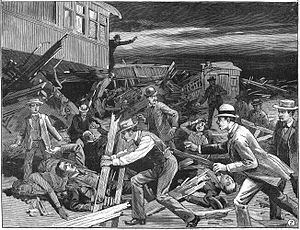Time Approximately midnight Cause Bridge collapse Passengers 700 Date 10 August 1887 Passenger count 700 | Type of incident Derailment Trains 1 Deaths 81–85 | |
 | ||
Operator Toledo, Peoria and Western Railway Similar 1947 Centralia mine disa, Ashtabula River railroad d, Great Train Wreck of 1918, 1909 Cherry Mine disa, Hammond Circus Train Wre | ||
The 1887 Great Chatsworth train wreck was a major rail accident that occurred late on the night of August 10, 1887, 3 miles (5 km) east of the town of Chatsworth, Illinois, in the United States. A Toledo, Peoria and Western Railroad (TP&W) train bound for Niagara Falls from Peoria crossed over a trestle, weakened earlier in the day by a fire, causing it to collapse. Between 81 and 85 people were killed, and between 169 and 372 injured.
Contents
Crash
900 people were on the train when it wrecked. The death count according to the Chicago Daily, August 13, 1887, was 355 people. On August 18 Timothy Coughlin was arrested and held responsible for the devastating crash. The summer of 1887 had been hot and dry. Fearing that sparks from the steam engines of the trains could ignite brush fires, the TP&W company began performing controlled burns to prevent an uncontrollable brush fire. On the day of the accident, TP&W crews performed a controlled burn near the site of the accident—it is suspected that failure to extinguish the fire resulted in charring of the bridge.
That evening, a TP&W train departed Peoria, traveling east through Eureka and Chenoa. Two steam engines pulled six fully loaded wooden passenger cars, six sleeper cars, and three luggage cars. In total, the train carried about 700 vacationers taking advantage of a special offer to visit Niagara Falls. Just before the accident site, the coach accelerated down a slope, reaching 40 miles per hour (64 km/h). The first engine successfully crossed the weakened bridge as it collapsed; the second engine crashed into the side of the hill, while each following passenger car telescoped into the next. Sleeper cars attached to the rear of the train halted just short of the bridge.
Four days later, the TP&W gathered together the remaining wreckage and set it on fire. The crash resulted in the increased use of steel in passenger cars.
Historical marker
In 1954, the state of Illinois placed a historical marker commemorating the event along U.S. Route 24. The marker has the following text:
